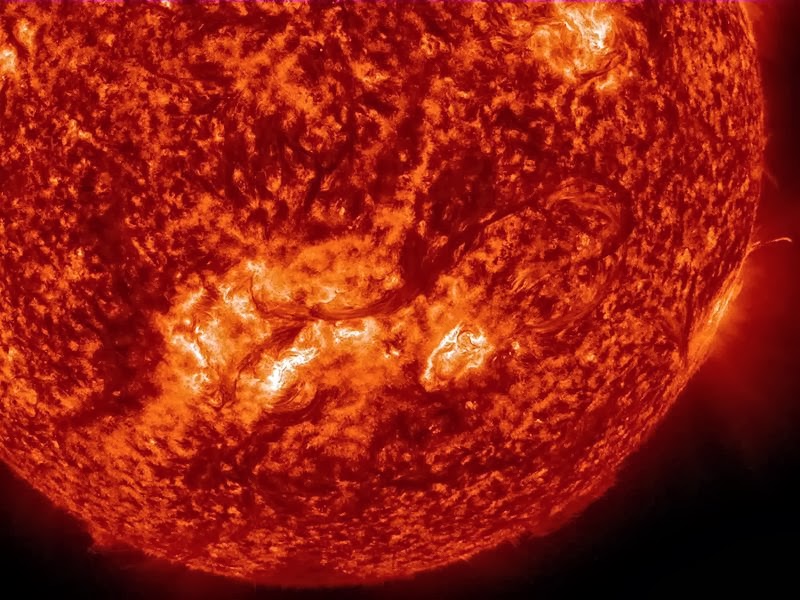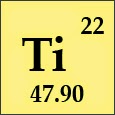Biology
Infrared are radiations with a wavelength from 800nm to 1mm. They were discovered by Friederich Wilhelm Herschel in 1800. The most important Infrared rays are called near infrared, with wavelengths from 800nm to 1micron (one million microns equals one meter). These radiations are very important, because they are the main way the heat is transmitted from the Sun to the Earth. In fact, these are the main radiations that warm the planet.
- #101 Photosynthetic Pigments
Photosynthetic pigments are pigments presented in chloroplasts or photosynthetic bacteria. They capture light energy necessary for photosynthesis and convert it to chemical energy. PigmentsA pigment is any substance that absorbs light.The color...
- Titanium (ti)
Term: titaniumLiterally meaning: ?pertaining to Titans?Origin: Anc Greek?????/Titan(= in Greek Mythology Titans and their sisters Titanesses were giant and strong primordial dieities children of Gaia (Earth) and Uranus (sky). Titans were...
- Photon
Term: photonLiterally meaning: ?that carry light?Origin: Anc Greek???/phos(=light) > (genitive ?????/photos=of light) Coined/Historyby Gilbert Lewis in 1926, though the concept of light in the form of discrete particles had been known. Definition(physics)...
- Cancer: Types, Causes, Diagnosis And Treatment
CANCER · Cancer is an abnormal and uncontrolled multiplication of cells resulting in the formation of tumor.· Normal cells show a contact inhibition (contact with the other cells inhibits their uncontrolled growth)....
- Human Beings Love Sun
SunlightMost humans beings love Sun, love summer, and the images of crowded beaches are typical everywhere when fair weather comes. Why are we so fond of Sun. Maybe the answer to this question is not easy, maybe each person has their own reasons. But...
Biology
From the Sun to the skin, from the hydrogen to the titanium.
 |
| The Sun |
According to the current Harvard stellar classification, the Sun is a G2 star. In this group we can find yellow colored celestial bodies, with temperatures ranging from 4,500 to 6,000K and around 2x10^30Kg of mass.
The stars are large spherical bodies of plasma. their heat and energy is provided by nuclear fusion that takes place in the core. These nuclear reactions were described by Carl Friedrich von Weizsäcker and Hans Bethe between 1937 and 1939. In this process, two atoms of Hydrogen undergo a transmutation into Helium, releasing great amounts of Energy.
This Energy is mainly released as electromagnetic radiation. Electromagnetic radiation is a type of energy transmitted as a wave. In this wave, its amplitude is related to the intensity of the radiation. The wavelength is related to the type of electromagnetic radiation. The wave transports more energy
when its amplitude is higher and when its wavelength is shorter. So, the electromagnetic wave is more energetic if it has shorter wavelength. In other words, short wavelength waves are more energetic.
 |
| Carl Friederich von Weizäcker |
The electromagnetic radiation emitted by the Sun is quite complex and has waves with all the range of wavelengths, from less than 10nm (one million billion nanometers equals one meter) to more than one meter. And, as we said, the shortest wavelengths are the most energetic ones.
Of all the radiation produced by the Sun, only a part reaches the Earth?s atmosphere. The most energetic radiations, such as X-rays or Gamma rays are in such low quantity that they have no effects on our planet. The most abundant radiation is Infrared. Around than 55%, to be accurate.
 |
| Friedrich Wilhelm Herschel |
Radiations with wavelength from 400nm to 800nm are related to visible light. All the colours we see are electromagnetic waves of these types. The ranges near 800nm are related to colour red, the ranges near 400nm are related to violet colors. Between these two edges, we can find all the variety of colors. Visible light is around the 40% of the total light radiation that reach the Earth.
The rest of radiation that reaches the planet (less than 5%) is mainly ultraviolet radiation.
Ultraviolet rays were discovered in 1800 by a lonely sad fellow called Johann Wilhelm Ritter. Their wavelength are between 200nm to 400nm, so they are more energetic than visible rays and much more than ultraviolet rays.
 |
| Johann Wilhelm Ritter |
Ultraviolet radiations cause severe damage to living beings. They have the ability to result in chemical changes in DNA, that lead to mutations. DNA mutation could transform regular cells into tumorous ones.
In fact, ultraviolet radiations are related to the most common types of skin cancers. The effect of the rays is not conspicuous thanks to the absorption of a large amount of them by the ozone layer of the atmosphere.
The ozone layer is a part of the stratosphere rich in ozone, a molecular form of oxygen (O3). The ultraviolet rays are absorbed by ozone and its energy is used to transform ozone into molecular oxygen. This keeps us safe, but the thickness of the ozone layer was reduced along the 20th century. It?s easy to prove that reduction of the ozone layer has run parallel to the increase in skin cancer.
To avoid the damage humans have a natural protection: melanin. Melanin is a pigment of our skin that absorbs ultraviolet radiation to preserve our inner tissues. The main problem is that in many people, melanin is only produced in significant amounts after skin damage, and this production is quite slow. So, you are only protected when your body has been exposed to the radiation at the first time, unless your skin has naturally great amounts of melanin. This occurs in dark skinned people.
We have also manufactured products to protect us. They are called solar protectors. A very common component used to solar protection is titanium dioxide. Powdered titanium dioxide is a white dusty substance that can cover our skin. The solar rays shock against the titanium particles and don?t reach our cells.


Titanium is a metal characterized by its great strength weight relation, what it means that is a very strong metal in relation to its weight. It was discovered by William Gregor in 1791 as a component of the mineral called ilmenite and named by Martin Heinrich Klaproth (that found this metal in the mineral called rutilus the same year, a bit later, but was the first to give it an official title).
Titanium can be found in the Sun in low quantities, but it is more frequent in M-type stars. And is abundant in the rocks that the Apollo 17 brought back from the moon.
- #101 Photosynthetic Pigments
Photosynthetic pigments are pigments presented in chloroplasts or photosynthetic bacteria. They capture light energy necessary for photosynthesis and convert it to chemical energy. PigmentsA pigment is any substance that absorbs light.The color...
- Titanium (ti)
Term: titaniumLiterally meaning: ?pertaining to Titans?Origin: Anc Greek?????/Titan(= in Greek Mythology Titans and their sisters Titanesses were giant and strong primordial dieities children of Gaia (Earth) and Uranus (sky). Titans were...
- Photon
Term: photonLiterally meaning: ?that carry light?Origin: Anc Greek???/phos(=light) > (genitive ?????/photos=of light) Coined/Historyby Gilbert Lewis in 1926, though the concept of light in the form of discrete particles had been known. Definition(physics)...
- Cancer: Types, Causes, Diagnosis And Treatment
CANCER · Cancer is an abnormal and uncontrolled multiplication of cells resulting in the formation of tumor.· Normal cells show a contact inhibition (contact with the other cells inhibits their uncontrolled growth)....
- Human Beings Love Sun
SunlightMost humans beings love Sun, love summer, and the images of crowded beaches are typical everywhere when fair weather comes. Why are we so fond of Sun. Maybe the answer to this question is not easy, maybe each person has their own reasons. But...
